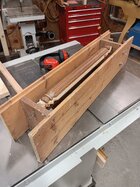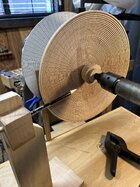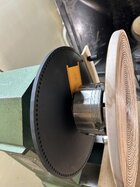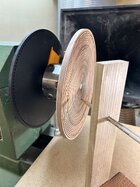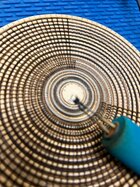Read an article on how a basket illusion maker used a home built index system to do his indexing/line burning off the lathe. Can’t find the article, didn’t have plans anyway. Does anyone have a set up like this ? If so care to share? Be nice not tying up the lathe and possibly sit down to do the burning part of a basket illusion. Thanks
-
Congratulations to Rick Moreton, People's Choice in the July 2025 Turning Challenge (click here for details) -
Congratulations to Michael Foster for "Costa II" being selected as Turning of the Week for July 28th, 2025 (click here for details) -
Welcome new registering member. Your username must be your real First and Last name (for example: John Doe). "Screen names" and "handles" are not allowed and your registration will be deleted if you don't use your real name. Also, do not use all caps nor all lower case.
You are using an out of date browser. It may not display this or other websites correctly.
You should upgrade or use an alternative browser.
You should upgrade or use an alternative browser.
Indexing off the lathe
- Thread starter Ted Pelfrey
- Start date
Read an article on how a basket illusion maker used a home built index system to do his indexing/line burning off the lathe. Can’t find the article, didn’t have plans anyway. Does anyone have a set up like this ? If so care to share? Be nice not tying up the lathe and possibly sit down to do the burning part of a basket illusion. Thanks
Sorry, I haven't seen that. Do you remember what publication? Could it be this:
I've thought about documenting the steps of my style of basket illusion for a while and thought this would be a good a place to give it a try. Keep in mind that there are probably as many different ways to do this as there are people doing it and mine is only one of them. And I also need to give credit and thanks to those who taught me most of this. I was first inspired by Jim Adkins several years before I ever tried this myself. And to this day I still think his baskets are the most realistic I've seen. Steve Mawson has also been a huge inspiration to me and also become a good friend...
- Curt Fuller
- Replies: 65
- Forum: Tutorials and Tips
I do have a Alisam indexer for the wood lathe (on the advise of John Lucas) but I don't think it has enough divisions for the faux baskets.
Now for something way out in left field...
I use a precision rotary table for my milling machine and I've used it, not for illusive baskets but for laying out patterns for chip carving on round things. A bit pricey but extremely precise. Not something easily made at home!
A rotary table is extremely handy at the mill!
For example, I mounted a vise on it and used it to mill the precise angles for this logo on a chunk of bronze.
A friend wanted to make a branding iron for her dad's woodworking - with the family sheep farm logo.
A rotary table is one of those things that once you use it you can't live without it.

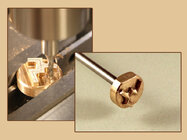
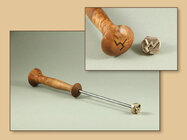
JKJ
- Joined
- Nov 27, 2021
- Messages
- 216
- Likes
- 866
- Location
- Silver Spring, MD
- Website
- www.transpirationturning.com
If you hate having to do the indexing and burning the lines, there is always automation. It is shown "on the lathe" here, but can also be done off.
Thanks Paul. Oh no I don’t hate it . Just would like to do it off the lathe. The guy I saw had a homemade indexing jig . I can bring it to work and possibly get my indexing done at work , and not tie up my lathe.If you hate having to do the indexing and burning the lines, there is always automation. It is shown "on the lathe" here, but can also be done off.
A little off the wall but a dividing head or a spin indexer would work. Both are standard metalworking accessorizes. A lot of dividing heads have a 1-1/2"-8 spindle thread so you need an adapter to 1-1/4-8 to mount a chuck. The spin indexer is cheaper but only uses 5C collets. I often use the dividing head on my Bridgeport to flute bowls, slot Christmas ornaments, and spindle work.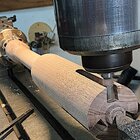
Lathe chuck top left in the picture mounted on a dividing head so I can cut sliding dovetails in the center spindle for a Shaker candle stand. Last weeks work.

Lathe chuck top left in the picture mounted on a dividing head so I can cut sliding dovetails in the center spindle for a Shaker candle stand. Last weeks work.
Thanks Larry . I need something small and light , portable.A little off the wall but a dividing head or a spin indexer would work. Both are standard metalworking accessorizes. A lot of dividing heads have a 1-1/2"-8 spindle thread so you need an adapter to 1-1/4-8 to mount a chuck. The spin indexer is cheaper but only uses 5C collets. I often use the dividing head on my Bridgeport to flute bowls, slot Christmas ornaments, and spindle work.View attachment 78009
Lathe chuck top left in the picture mounted on a dividing head so I can cut sliding dovetails in the center spindle for a Shaker candle stand. Last weeks work.
Sorry, I haven't seen that. Do you remember what publication? Could it be this:
From a quick glance it looks like Curt Fuller is using polar graph paper to define the divisions. Could you use some? (I think I have a stash of polar and nearly every other kind of graph paper made - anyone need some log-log?)I've thought about documenting the steps of my style of basket illusion for a while and thought this would be a good a place to give it a try. Keep in mind that there are probably as many different ways to do this as there are people doing it and mine is only one of them. And I also need to give credit and thanks to those who taught me most of this. I was first inspired by Jim Adkins several years before I ever tried this myself. And to this day I still think his baskets are the most realistic I've seen. Steve Mawson has also been a huge inspiration to me and also become a good friend...
- Curt Fuller
- Replies: 65
- Forum: Tutorials and Tips
I do have a Alisam indexer for the wood lathe (on the advise of John Lucas) but I don't think it has enough divisions for the faux baskets.
Now for something way out in left field...
I use a precision rotary table for my milling machine and I've used it, not for illusive baskets but for laying out patterns for chip carving on round things. A bit pricey but extremely precise. Not something easily made at home!
A rotary table is extremely handy at the mill!
For example, I mounted a vise on it and used it to mill the precise angles for this logo on a chunk of bronze.
A friend wanted to make a branding iron for her dad's woodworking - with the family sheep farm logo.
A rotary table is one of those things that once you use it you can't live without it.
View attachment 78000
View attachment 78001
View attachment 78002
JKJ
Wow. I bought a $600 CNC a few weeks ago. Haven't done much with it yet. It's got an 800w spindle capable of doing aluminum and brass. Anolex 3030 Max.
If you hate having to do the indexing and burning the lines, there is always automation. It is shown "on the lathe" here, but can also be done off.
That's the perfect use of a CNC, even for people who think CNCs don't belong in woodturning.
Some day, Paul. Some day.
Hmm... I have a rotary attachment for my laser that I can get a "chuck" for. I may need to try some experiments.If you hate having to do the indexing and burning the lines, there is always automation. It is shown "on the lathe" here, but can also be done off.
john lucas
AAW Forum Expert
- Joined
- Nov 27, 2021
- Messages
- 216
- Likes
- 866
- Location
- Silver Spring, MD
- Website
- www.transpirationturning.com
It can work well on things that are more spindle-like. As you get to more bowl/plate pieces you end up having to make non-orthogonal lines, so you need a machine that can change tool position. In my video you might even notice the laser angle actually follows the profile of the piece.Hmm... I have a rotary attachment for my laser that I can get a "chuck" for. I may need to try some experiments.
I don't fully understand basket illusion. Is it just to provide a design or is it to make something that actually looks like a woven basket? First time I became aware of basket illusions my thought was why not actually weave a real basket?
The indexing shown in post #3 using a laser is not correct for segment spacing on a real woven basket. Each coil of a real basket should be divided into a different number of equal segments. That's fairly easily done on a programmable device like a CNC. Take the 360 degree length of a coil, divide by the segment spacing to come up with the number of segments for that particular coil.
CNC in woodturning... nothing at all wrong with it. Just another tool to achieve your designs.
The indexing shown in post #3 using a laser is not correct for segment spacing on a real woven basket. Each coil of a real basket should be divided into a different number of equal segments. That's fairly easily done on a programmable device like a CNC. Take the 360 degree length of a coil, divide by the segment spacing to come up with the number of segments for that particular coil.
CNC in woodturning... nothing at all wrong with it. Just another tool to achieve your designs.
- Joined
- Nov 27, 2021
- Messages
- 216
- Likes
- 866
- Location
- Silver Spring, MD
- Website
- www.transpirationturning.com
This is just simple segmentation. My program can define how many segments are created over any particular length, so you can approximate a woven basket. Doing it over each coil would be be tedious and since by definition it is an illusion, there is no reason to make it exactly as a woven basket.The indexing shown in post #3 using a laser is not correct for segment spacing on a real woven basket. Each coil of a real basket should be divided into a different number of equal segments. That's fairly easily done on a programmable device like a CNC. Take the 360 degree length of a coil, divide by the segment spacing to come up with the number of segments for that particular coil.
Ted,
This is my indexing system set up on my lathe but I don’t see why you couldn’t make something with a Chuck to hold your work and it could sit on your kitchen table if need be. I usually use 48 or 72 divisions for my work. Takes me about an hour to index both sides of a 12” platter. I’ve never used anything to burn lines on the lathe. Easy enough sitting at my study desk at home.
This is my indexing system set up on my lathe but I don’t see why you couldn’t make something with a Chuck to hold your work and it could sit on your kitchen table if need be. I usually use 48 or 72 divisions for my work. Takes me about an hour to index both sides of a 12” platter. I’ve never used anything to burn lines on the lathe. Easy enough sitting at my study desk at home.
Attachments
Ted,
Mine is similar to Mark's but I enhanced the indexing with a wheel that I 3D printed. I use it on lathe like Mark and then burn in at my leisure. I am intrigued by the short video that Paul P. added to the conversation would like to know more about this - likely beyond my ability to fabricate but it sure looks slick.
Picks of my set-up below. The first one shows how I index the plate, the second drawing the lines and the third off lathe burning.
Mine is similar to Mark's but I enhanced the indexing with a wheel that I 3D printed. I use it on lathe like Mark and then burn in at my leisure. I am intrigued by the short video that Paul P. added to the conversation would like to know more about this - likely beyond my ability to fabricate but it sure looks slick.
Picks of my set-up below. The first one shows how I index the plate, the second drawing the lines and the third off lathe burning.
Attachments
Thanks guys. I use the Chef Ware indexing system on my lathe. Works great! I would just like some type of plans on how to make that portable. Something fairly light weight so could take it to work to do my indexing/burning off lathe. So I guess I would need some kind of shaft /spindle for my chuck and chef ware indexing wheel? Not very Mechanically inclined.
- Joined
- Nov 27, 2021
- Messages
- 216
- Likes
- 866
- Location
- Silver Spring, MD
- Website
- www.transpirationturning.com
This is done with the LatheEngraver. It does a whole bunch of things. You can do some searching or click on the link below this (or in the profile picture area).I am intrigued by the short video that Paul P. added to the conversation would like to know more about this - likely beyond my ability to fabricate but it sure looks slick.
Thanks guys. I use the Chef Ware indexing system on my lathe. Works great! I would just like some type of plans on how to make that portable. Something fairly light weight so could take it to work to do my indexing/burning off lathe. So I guess I would need some kind of shaft /spindle for my chuck and chef ware indexing wheel? Not very Mechanically inclined.
I have seen plain spindle adapters for sale somewhere. It’s an adapter with the thread of your choice (to fit your chuck) with a plain bore. A suitable shaft to fit the bore could then form the basis of an indexing system?
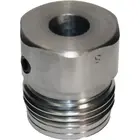
No, doing it over each coil would not be tremendously tedious on a programmable device such as a CNC. Only a bit more effort than what you've shown.This is just simple segmentation. My program can define how many segments are created over any particular length, so you can approximate a woven basket. Doing it over each coil would be be tedious and since by definition it is an illusion, there is no reason to make it exactly as a woven basket.
Illusion.... yeah, okay, if you don't want it to be realistic. Otherwise it isn't much more than coloring a checker board, is it?
For indexing here's a ready made system.
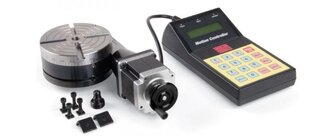
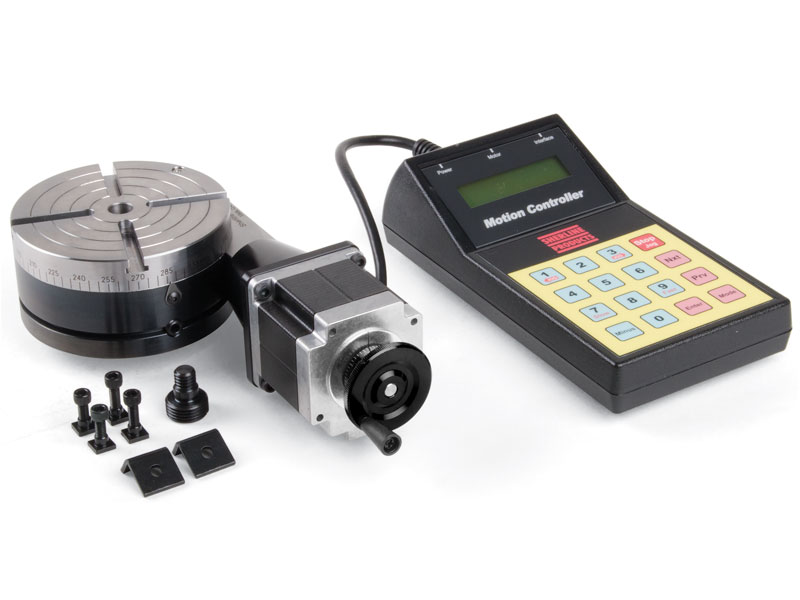
 www.sherline.com
www.sherline.com
At it's price around $900 it may be a budget buster. But the same system can be put together closer to $300 by building it yourself with an arduino processor.


CNC Rotary Table Indexer - Sherline Products
Sherline has advanced its precision 4" rotary table into the 21st century with the addition of Computer Numerical Control (CNC). This upgrade makes it an ideal solution for clockmakers, gear cutters, and anyone needing to machine intricate radially symmetrical patterns. The CNC rotary table...
At it's price around $900 it may be a budget buster. But the same system can be put together closer to $300 by building it yourself with an arduino processor.
Here's another indexing system. Currently on sale 25% off. Uses your cell phone as a controller. I use one to photograph items for photogrammetry.

 edelkrone.com
edelkrone.com

HeadONE v2
HeadONE is a motorized camera pan/tilt solution that is unmatched in terms of portability and versatility. With a user-friendly app for control, HeadONE can be paired with another HeadONE for a full motorized camera head experience. HeadONE is also designed with affordability in mind, making...
I have seen plain spindle adapters for sale somewhere. It’s an adapter with the thread of your choice (to fit your chuck) with a plain bore. A suitable shaft to fit the bore could then form the basis of an indexing system?
View attachment 78069
That's an insertNova sells with the external 38mm metric thread to fit all their insert chucks:
Also, Best Wood Tools makes a chuck adapter with a shaft, it that would fit most chucks, including those for the "std" 1-1/4x8 lathe spindles.
As for mechanical indexers, Little Machine shop has a number of options.
All depends on the precision desired. These use std machinist mounting hardware. The cheapest one may be sufficient.
(I've purchased many things from LMS and they have been reliable. I have one of these but can't remember which one.)
JKJ
- Joined
- Nov 27, 2021
- Messages
- 216
- Likes
- 866
- Location
- Silver Spring, MD
- Website
- www.transpirationturning.com
Spoken like someone that is thinking about it theoretically, but not in practice. You have to know the diameter of each coil/bead. You have to know the distance across each bead, which may not be consistent over the whole piece. To do it "right" you also need to know the normal angle of the bead. Multiply that by however many beads are on the piece and you've just spent a non-trivial amount of time just getting measurements.No, doing it over each coil would not be tremendously tedious on a programmable device such as a CNC. Only a bit more effort than what you've shown.
Illusion.... yeah, okay, if you don't want it to be realistic. Otherwise it isn't much more than coloring a checker board, is it?
I've come up with an automation solution that mimics how most turners that make basket illusions index and burn their lines. It isn't something I have a lot of interest in, but I think many of those pieces are amazing, even if they are just coloring a checker board.
Spoken like someone that is thinking about it theoretically, but not in practice. You have to know the diameter of each coil/bead. You have to know the distance across each bead, which may not be consistent over the whole piece. To do it "right" you also need to know the normal angle of the bead. Multiply that by however many beads are on the piece and you've just spent a non-trivial amount of time just getting measurements.
I've come up with an automation solution that mimics how most turners that make basket illusions index and burn their lines. It isn't something I have a lot of interest in, but I think many of those pieces are amazing, even if they are just coloring a checker board.
No Paul, not theoretical at all.
My method assumes the coils have equal spacing. Also assumes the coils are cut on a CNC, but if they aren't cut on a CNC for equal spacing the bowl could be probed to establish coils spacing. Also assumes the coils are not helical, but just stacked rings.
Layout a 2D image of the bowl. Black line is outside of bowl, red lines are coils.

Generate 2D Gcode from that.
It'll be in the form:
G00 Xcoil1start Y0
G01 Xcoil1end Y0
G00 Xcoil2start Ycoil2height
and so on.....
Run the Gcode through a spreadsheet to determine coil length and divide by segment width.
Bingo... you've got a program to burn or cut segments. Use a rotary axis or use virtual rotation to simulate actual rotation. Angles may be like 21.3nn degrees not necessarily whole numbers.
My mill has conversational programming with a macro language, math functions and if/then branching. Most anything is possible. The tool path is determined on the fly rather than pre-generation.
Same basic process to cut multi-axis turnings with 50 axis offsets per inch.
Hopefully this makes sense to you. The spreadsheet program I use is not public domain, I own it and have sold copies, but not cheap.
Jim McLain
Artist
Karl Hansen has a few videos on his process in YouTube. One shows his off lathe indexing system. He uses one of Tom Lohmans indexing plates.
- Joined
- Nov 27, 2021
- Messages
- 216
- Likes
- 866
- Location
- Silver Spring, MD
- Website
- www.transpirationturning.com
Let's not assume the piece itself was made on a CNC. I love using CNC methods in woodturning, but I for one (and nearly everyone else) still likes turning by hand.My method assumes the coils have equal spacing. Also assumes the coils are cut on a CNC, but if they aren't cut on a CNC for equal spacing the bowl could be probed to establish coils spacing. Also assumes the coils are not helical, but just stacked rings.
I do not believe you will be able to probe the surface features of a bowl that has a series of directly stacked beads. This is how most basket illusion pieces are done and most of these beads are very small. Good luck trying to get a touch probe between them to accurately measure the transition point between those beads. What happens when you get that wrong, or if it is off a millimeter? It looks terrible. It isn't an issue when burning by hand if one line is a little long, but once every line is off it doesn't look good. I know this because I've actually done it.
I've designed and built a 4-axis CNC machine with woodturning in mind (embellishments, not automated turning). It makes sense, but I posit that what you have described is still theoretical.Hopefully this makes sense to you. The spreadsheet program I use is not public domain, I own it and have sold copies, but not cheap.
I guess we have different attitudes about software tools. All the software I develop is publicly available under AGPL licenses and available on github for anyone to use, modify, and improve upon (and I hope they will improve upon it; I'm NOT a software engineer!)
Doug once again a loggerhead. My Shark CNC would not be able to make a decent size bowl or hollow form to make the basket illusion if at all. One would need a much bigger/taller CNC or one with a 4th or 5th axis at least. Paul's Lathe Engraver will do things that the CNC I own will not do (at least easily) in conjunction with woodturning. For me I wish I knew at the beginning that Paul was going to sell complete machines as starting from scratch at my age has been a little bit of a challenge. But there is no doubt that I would be able to do the things that can be done with the Lathe Engraver that without spending many thousands of dollars on a regular CNC machine. A point to all the software to run my CNC costs roughly $2000, the software to run Paul's machine is free.
Ted, I think I would buy some threaded rod and nuts that matches your lathe spindle. (McMaster Carr). Build a plywood box to mount it in. You can make an indexing wheel out of a plywood disc and use fixturing like your chef ware kit or adapt the chef ware system to fit.
I haven’t ever seen plans for something like this but it could be kept quite simple.
I haven’t ever seen plans for something like this but it could be kept quite simple.
- Joined
- Nov 27, 2021
- Messages
- 216
- Likes
- 866
- Location
- Silver Spring, MD
- Website
- www.transpirationturning.com
This is basically the motorized aluminum extrusion version of what you are describing. 12" 1.25-8 threaded rod from McMaster. The only specialized pieces are are pockets cut in the upright extrusion for bearings to hold the spindle. An indexing-only setup could get away with just holes drilled through. Everything else is just off the shelf hardware (spindle nuts are 3D printed because 1.25" nuts are quite expensive).Ted, I think I would buy some threaded rod and nuts that matches your lathe spindle. (McMaster Carr). Build a plywood box to mount it in. You can make an indexing wheel out of a plywood disc and use fixturing like your chef ware kit or adapt the chef ware system to fit.
I haven’t ever seen plans for something like this but it could be kept quite simple.
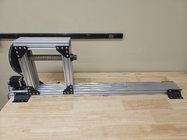
Yeah I like that. I’d buy the nuts - I don’t have a 3D printer. I’d probably just trap an indexing wheel between the chuck and spindle nut, rather than the indexer/ controller for a portable unit. Then you can set up anywhere without needing power…….. although if you are using a burner pen, I guess you need power anyhow…..hmmm some options.This is basically the motorized aluminum extrusion version of what you are describing. 12" 1.25-8 threaded rod from McMaster. The only specialized pieces are are pockets cut in the upright extrusion for bearings to hold the spindle. An indexing-only setup could get away with just holes drilled through. Everything else is just off the shelf hardware (spindle nuts are 3D printed because 1.25" nuts are quite expensive).
View attachment 78091
Paul, what does the indexing system / controller setup cost?
- Joined
- Nov 27, 2021
- Messages
- 216
- Likes
- 866
- Location
- Silver Spring, MD
- Website
- www.transpirationturning.com
I sell that unit (minus the motor and motor mount) for ~$200.Paul, what does the indexing system / controller setup cost?
You can certainly buy just the hardware for under $100. There is some effort needed to cut the bearing recesses.
An indexing system wouldn't even require the 1 meter extrusion as the base.
To convert it from manual to motorized version would add about $30 for a stepper motor, ~$60 for a controller, and a bit more for a power supply.
The advantage of that is that you get perfect indexing, and you can use it for low RPM (0-30 RPM) continuous motion for finishing applications. The controller software I've written you just tell it `rotate 10 20` and it will rotate at 10 RPM for 20 minutes.
Paul, I'm not going to argue with you. What I described is very doable. I've used it many times in doing multi-axis turning.
I don't like hand turning. I'd rather have a root canal without Novocaine than hand turn. What I like is design and having machines create the "turnings".
Off by a millimeter? The probe on my mill is accurate to several tenths.
That's wonderful, but this is something I did for a living so why give it away? The only "real" job I ever had prior to self employment was 5 years as a software engineer/developer at Boeing.
It's impressive you've built a 4 axis CNC. That's no small accomplishment. But I view that just like what the OT people do, they build stepper motor setups that cost a fortune when you can buy a factory built CNC and software that'll do it all easier and better right out of the box.
I love using CNC methods in woodturning, but I for one (and nearly everyone else) still likes turning by hand.
I don't like hand turning. I'd rather have a root canal without Novocaine than hand turn. What I like is design and having machines create the "turnings".
What happens when you get that wrong, or if it is off a millimeter?
Off by a millimeter? The probe on my mill is accurate to several tenths.
All the software I develop is publicly available under AGPL licenses and available on github for anyone to use, modify, and improve upon (and I hope they will improve upon it; I'm NOT a software engineer!)
That's wonderful, but this is something I did for a living so why give it away? The only "real" job I ever had prior to self employment was 5 years as a software engineer/developer at Boeing.
It's impressive you've built a 4 axis CNC. That's no small accomplishment. But I view that just like what the OT people do, they build stepper motor setups that cost a fortune when you can buy a factory built CNC and software that'll do it all easier and better right out of the box.
Last edited:
As Don Wattenhofer pointed out to me in an earlier, unrelated thread:
If you use a chuck to live center adapter, then you can replace the costly 1 1/4" rod and nut with less costly 3/4" x 10 tpi hardware.
If you use a chuck to live center adapter, then you can replace the costly 1 1/4" rod and nut with less costly 3/4" x 10 tpi hardware.
- Joined
- Nov 27, 2021
- Messages
- 216
- Likes
- 866
- Location
- Silver Spring, MD
- Website
- www.transpirationturning.com
Then please show us your basket illusion.Paul, I'm not going to argue with you. What I described is very doable. I've used it many times in doing multi-axis turning.
Thanks for putting that in quotes.I don't like hand turning. I'd rather have a root canal without Novocaine than hand turn. What I like is design and having machines create the "turnings".
You missed my point entirely. It isn't the accuracy of your probe, it is the ability to accurately identify the positions of the valleys between the beads (where the laser would need to traverse). You have to have a tiny tip on your probe and you have to have a very high sample count to find those accurately. If you get those positions wrong, it looks bad. With your 3-axis mill I would argue you would never be able to get those accurate enough because you would need the probe to be very close to normal to the surface of the bowl.Off by a millimeter? The probe on my mill is accurate to several tenths.
I do it for fun and I want other people to have fun without it costing them a fortune.That's wonderful, but this is something I did for a living so why give it away? The only "real" job I ever had prior to self employment was as a software engineer/developer at Boeing.
This clearly shows that you aren't familiar with the machine I've built. It isn't expensive and it can do things that your factory built CNC cannot do at a fraction of the cost and much greater simplicity. This is because I designed it around woodturning applications.It's impressive you've built a 4 axis CNC. That's no small accomplishment. But I view that just like what the OT people do, they build stepper motor setups that cost a fortune when you can buy a factory built CNC and software that'll do it all easier and better right out of the box.
You can make shallow basket illusions. The limited work space between the cutter and the table of your CNC is a problem. To increase that space the rigidity of the machine has to increase exponentially which could make your CNC unaffordable.Doug once again a loggerhead. My Shark CNC would not be able to make a decent size bowl or hollow form to make the basket illusion if at all.
Think about what you can do. Oval bowls are simple without the Vicmarc $4K attachment. Very easy with the subset of Vectric software included with some CNC wood routers. Or buy the Vectric software for 350 bucks if you don't have it. How about an oval basket illusion? Fusion 360 is free to program very complicated objects, steep learning curve though.
john lucas
AAW Forum Expert
Ted Get with me. I think I can easily build you something that will work with your Chefware kits index plate. Just need to discuss how you will use it and what will be comfortable.
That would be awesome! Thank you so much!Ted Get with me. I think I can easily build you something that will work with your Chefware kits index plate. Just need to discuss how you will use it and what will be comfortable.
Ted Get with me. I think I can easily build you something that will work with your Chefware kits index plate. Just need to discuss how you will use it and what will be comfortable.
Using Ted’s existing index plate makes sense, that’s the approach I’d go for. You’re lucky over there as there are a number of options for index plates, over here I’ve only seen one.

